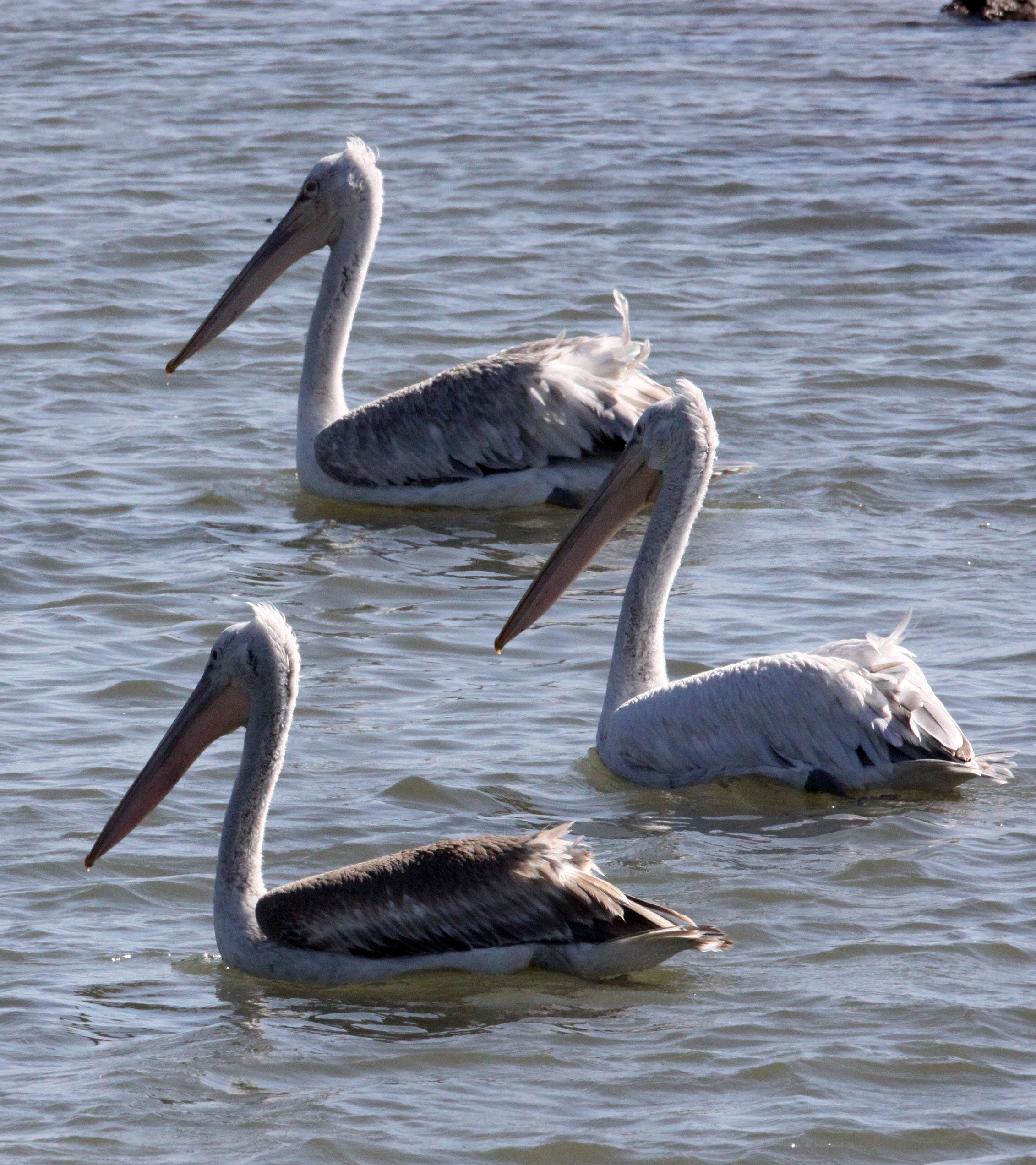
Pelicans

Brown Pelicans off the coast of Baja California, Mexico
Pelicans (genus Pelecanus) are a genus of large water birds that make up the family Pelecanidae. They are characterized by a long beak and a large throat pouch used for catching prey and draining water from the scooped-up contents before swallowing. They have predominantly pale plumage, except for the brown and Peruvian pelicans. The bills, pouches, and bare facial skin of all pelicans become brightly coloured before the breeding season. The eight living pelican species have a patchy global distribution, ranging latitudinally from the tropics to the temperate zone, though they are absent from interior South America and from polar regions and the open ocean.
Long thought to be related to frigatebirds, cormorants, tropicbirds, and gannets and boobies, pelicans instead are now known to be most closely related to the shoebill and hamerkop, and are placed in the order Pelecaniformes. Ibises, spoonbills, herons, and bitterns have been classified in the same order. Fossil evidence of pelicans dates back at least 36 million years to the remains of a tibiotarsus recovered from late Eocene strata of Egypt that bears striking similarity to modern species of pelican. They are thought to have evolved in the Old World and spread into the Americas; this is reflected in the relationships within the genus as the eight species divide into Old World and New World lineages. This hypothesis is supported by fossil evidence from the oldest pelican taxa.
Pelicans frequent inland and coastal waters, where they feed principally on fish, catching them at or near the water surface. They are gregarious birds, travelling in flocks, hunting cooperatively, and breeding colonially. Four white-plumaged species tend to nest on the ground, and four brown or grey-plumaged species nest mainly in trees. The relationship between pelicans and people has often been contentious. The birds have been persecuted because of their perceived competition with commercial and recreational fishing. Their populations have fallen through habitat destruction, disturbance, and environmental pollution, and three species are of conservation concern. They also have a long history of cultural significance in mythology, and in Christian and heraldic iconography.
The family Pelecanidae was introduced (as Pelicanea) by the French polymath Constantine Samuel Rafinesque in 1815. Pelicans give their name to the Pelecaniformes, an order which has a varied taxonomic history. Tropicbirds, darters, cormorants, gannets, boobies, and frigatebirds, all traditional members of the order, have since been reclassified: tropicbirds into their own order, Phaethontiformes, and the remainder into the Suliformes. In their place, herons, ibises, spoonbills, the hamerkop, and the shoebill have now been transferred into the Pelecaniformes. Molecular evidence suggests that the shoebill and the hamerkop form a sister group to the pelicans, though some doubt exists as to the exact relationships among the three lineages.
Within my short time in Thailand, Spot-billed Pelicans have gone from being a very rare resident to huge numbers today! Not sure why this has happened but I do see this as encouraging.
The eight living pelican species were traditionally divided into two groups, one containing four ground-nesters with mainly white adult plumage (Australian, Dalmatian, great white, and American white pelicans), and one containing four grey- or brown-plumaged species which nest preferentially either in trees (pink-backed, spot-billed and brown pelicans), or on sea rocks (Peruvian pelican). The largely marine brown and Peruvian pelicans, formerly considered conspecific, are sometimes separated from the others by placement in the subgenus Leptopelecanus but in fact species with both sorts of appearance and nesting behavior are found in either.
DNA sequencing of both mitochondrial and nuclear genes yielded quite different relationships; the three New World pelicans formed one lineage, with the American white pelican sister to the two brown pelicans, and the five Old World species the other. The Dalmatian, pink-backed, and spot-billed were all closely related to one another, while the Australian white pelican was their next-closest relative. The great white pelican also belonged to this lineage, but was the first to diverge from the common ancestor of the other four species. This finding suggests that pelicans evolved in the Old World and spread into the Americas, and that preference for tree- or ground-nesting is more related to size than genetics.

Australian Pelican (Pelecanus conspicillatus) Cairns Australia
Dalmatian Pelican (Pelecanus crispus) India
American White Pelican (Pelecanus erythrorhynchos) North America
Brown Pelican (Pelecanus occidentalis) Western North America
Great White (African) Pelican (Pelecanus onocrotalus) Africa & India
Spot-billed Pelican (Pelecanus philippensis) Thailand & India
Pink-backed Pelican (Pelecanus rufescens) East Africa
Peruvian Brown Pelican (Pelecanus thagus) Peru









